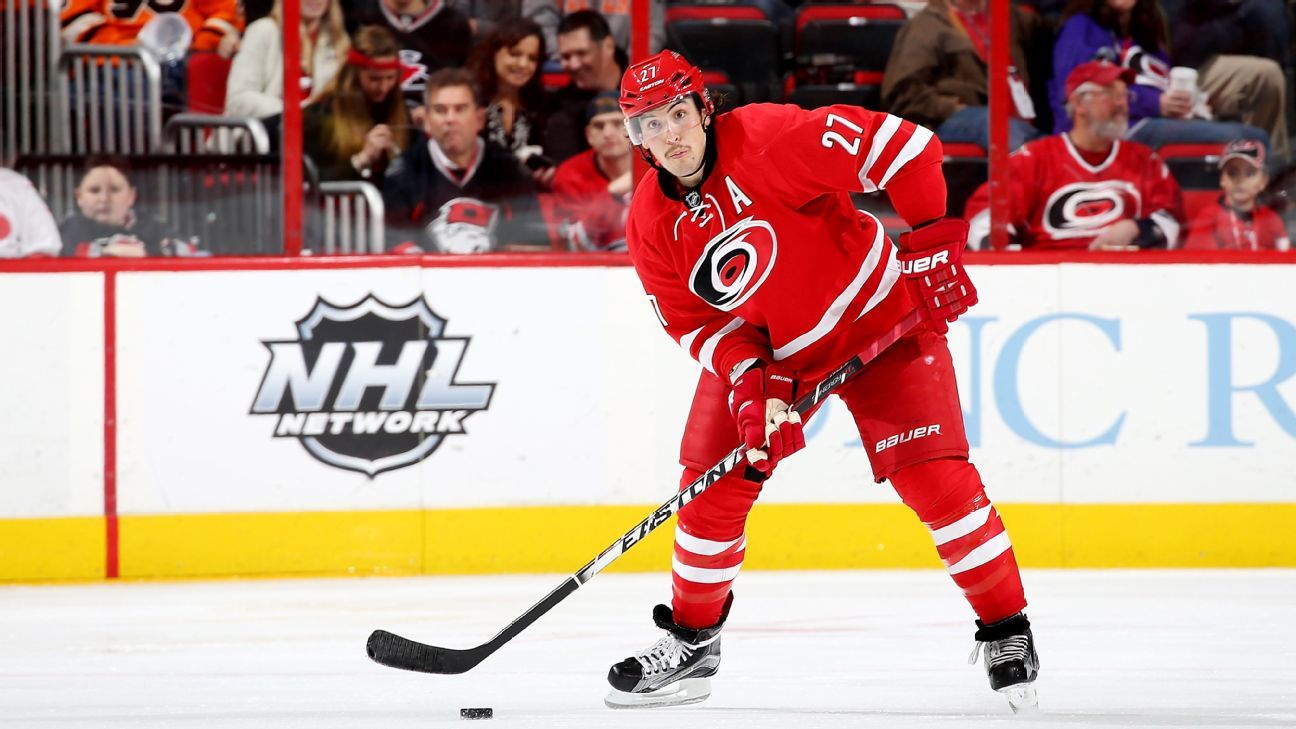Justin Faulk is the realistic Toronto Maple Leafs trade deadline target no one is talking about.
While Alex Pietrangelo, Dougie Hamilton and Colton Parayko would all represent major additions and all are sexier names, Faulk is the most likely player to be traded and he could be acquired for a fraction of the cost. He’s an all-situations defender, under contract through next season, and would clearly be an upgrade on Toronto’s current options.
On the right side of the Leafs blue line, Igor Ozhiganov’s ice time remains limited as we approach the 50-game mark, and I’d surprised if the Leafs are comfortable matching a 38-year-old Ron Hainsey (whose minutes are down two minutes per game this season) out against the top lines of the Bruins and Lightning come playoff time. Carolina could allocate Faulk’s $6 million in salary ($4.85M cap hit) towards a forward or a goaltender and it’s seemingly only a matter of time until they move a defenseman.
Justin Faulk Is A Realistic Target At The Deadline
The Toronto Maple Leafs are in the market for a right-shooting defenseman. As it just so happens, the Carolina Hurricanes are in the market to trade a right-shooting defenseman, with Faulk, Dougie Hamilton, Brett Pesce, and Trevor van Riemsdyk all matching that description. It seems like only a matter of time before one of them is on the move.
While they may listen to offers, the Hurricanes paid a hefty price to acquire Hamilton just last offseason. It would be shocking if they moved him this quickly, and it would be unusual to trade Pesce while he’s in the first year of his six-year deal. While Faulk may not be at the top of Toronto’s wish list, he’s the most likely player to be traded, and it’s not like the Leafs can afford to be too picky at this point.
Faulk is scheduled to hit free agency after next season. I don’t expect Carolina to let him walk in free agency for nothing and I don’t expect them to spend the money to extend him. He carries a $6 million salary both this year and next, and the Hurricanes ought to spend this money on a high-end forward or a goaltender. They could get a nice haul for Faulk at this year’s deadline, as teams will be willing to pay more to get two playoff runs out of him rather than one.
Why Faulk Is A Fit In Toronto
The Hurricanes care about salary, not cap hit. The Leafs care about cap hit, not salary. As a result, he’s a $4.83 million dollar player to the Leafs, but a $6 million dollar player to the Hurricanes. Faulk also carries a 15-team no-trade clause; since most contenders are set in terms of right-shooting defensemen, the Hurricanes probably don’t have a better trading partner here. This looks like a match.
The Leafs are likely to play the Boston Bruins in the first round of the playoffs, and as a result, they will have their hands full against a dominant top line. Ron Hainsey will be 38 by then and has arguably lost another step this season; he shouldn’t be matching up against Brad Marchand, Patrice Bergeron, and David Pastrnak in a playoff series (they’ve been there, done that, and the results are clear). Toronto simply does not have a high-end defensive pairing at the moment, and it’s clear that acquiring a top-four right-shooting defenseman needs to be the team’s top priority. Boston doesn’t carry a ton of forward depth, and if you can at least hold your own against their dominant top line, you have a good chance of winning the series.
Justin Faulk By The Numbers
Morgan Rielly has been glued to Ron Hainsey for a year-and-a-half now, and if anyone can relate to this, it’s Justin Faulk. Hainsey was Faulk’s primary partner during his time in Carolina and they were able to hold their own during these minutes:
Justin Faulk’s 5v5 Shot Attempt Differential, 2014-2017 (via Natural Stat Trick)
| Situation | TOI | CF% |
| Faulk With Hainsey | 1742 | 53.24 |
| Faulk Without Hainsey | 1763 | 53.63 |
| Hainsey Without Faulk | 1753 | 49.7 |
It’s easy to spot who was “driving play” on this pairing. I’m sure the Leafs would prefer to have this player next to Morgan Rielly. Furthermore, during Faulk’s final year with Hainsey, he finished second among NHL defensemen in goals despite missing seven games. However, after three consecutive seasons of scoring 15+ goals, his shooting percentage has dropped significantly in recent years:
Justin Faulk’s Shooting Percentage Slump
| Year | Sh% | Goals per 82 games |
| First Six Seasons | 6.80% | 13.5 |
| Last Two Seasons | 3.20% | 7.4 |
His goal-scoring reputation causes many people to view him as a power play specialist, but he’s a regular penalty-killer on a team with plenty of options and he logs a ton of ice-time at five-on-five. If the Leafs acquired him, they could continue to play Rielly and Jake Gardiner with the man-advantage and use Justin Faulk to matchup against team’s top lines after the power play expires. Faulk’s bomb from the point does offer a potentially valuable dynamic-changing option to a struggling Leafs power play, though.
MAGNUS Isolated 5v5 Impact (via hockeyviz.com)
| Player | Offensive (Positive is good) | Defensive (Negative is good) | Net Isolated Impact (Positive is good) |
| Justin Faulk | 2.7% | -2% | 4.7% |
| Ron Hainsey | 0.4% | 2.7% | -2.3% |
| Nikita Zaitsev | -0.9% | 8.1% | -9% |
Faulk isn’t a true number-one defenseman like Alex Pietrangelo, but he’s more likely to be traded at a fraction of the price. He’s clearly a major upgrade over Toronto’s current options and he could play big minutes both at five-on-five and on the penalty kill. Carolina’s four right-shooting defensemen are scheduled to earn $18.5 million next year, which is quite ridiculous for a team with such a low payroll.
Final Notes
– Another key point is that the Leafs should be able to acquire Faulk without giving up Timothy Liljegren or Rasmus Sandin. If you’re a fan of both of these prospects, Faulk is a nice option to help bridge the gap until they are ready for the top-four. If you’re not completely sold on these prospects, you may prefer to make a huge offer for Pietrangelo, as you’re going to have to give at least one of them away in order to land a player of his calibre.
– I have written before about Red Wings defenseman Nick Jensen, who seems to be a trendy target right now. He’s playing big minutes for Detroit right now, both at five-on-five and on the penalty kill, so it might take a second-round pick and a prospect to acquire him. The Red Wings are weak on the back-end, so they may want to extend him. Trading for Jensen does not prevent you from trading for someone like Faulk, and I am interested to see what it would take to lock him up for a few years.
– Similar to Faulk, Mark Pysyk is a player whose salary will exceed his cap hit next season, and Elliotte Friedman wrote that Florida appears to be willing to move him. He’s a $3.5 million player to Florida, but a $2.73 million player for a cap team like Toronto. The Leafs could offer Connor Brown, futures, or a cheaper defender like Igor Ozhiganov in return. However, I expect Dubas to target a better puck mover.
– The Hurricanes, who employ Eric Tulsky as their VP of Hockey Management and Strategy, may prefer to add two second-round picks rather than a late first. I wonder if the Leafs would prefer to go this route; Kyle Dubas could simply trade down in the draft again to re-gain another pick.

































